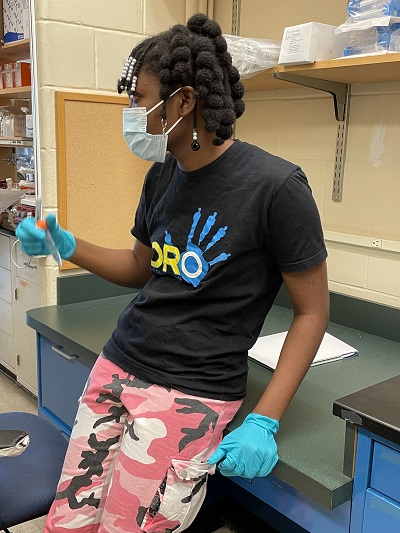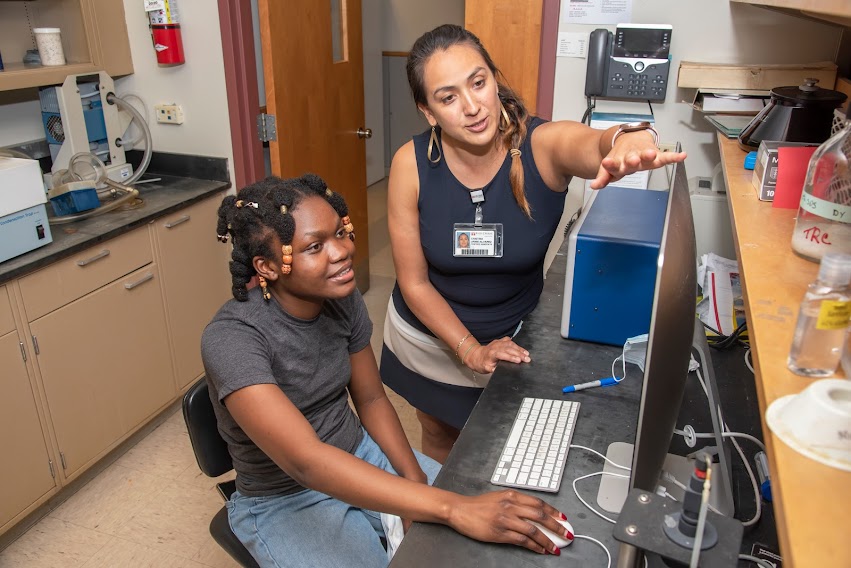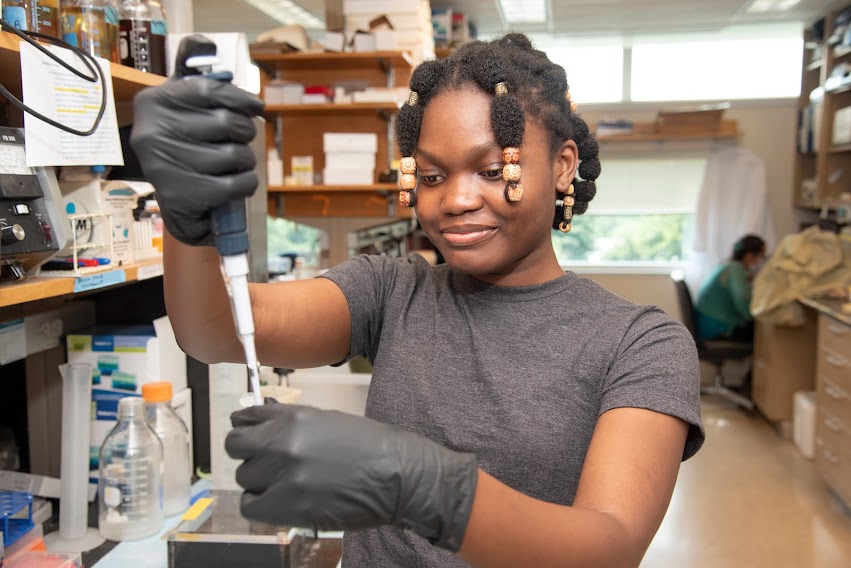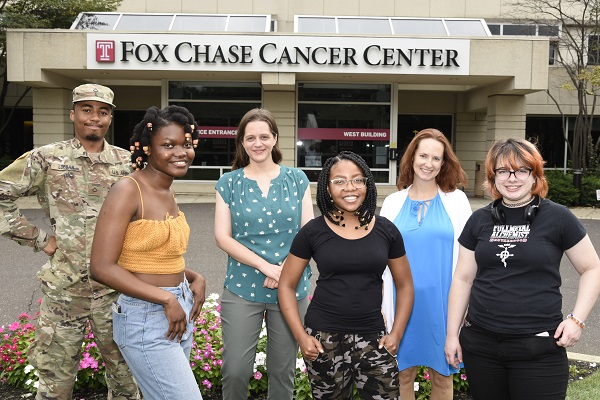
Baby Steps
02 July 2021

In the past four weeks, I have worked more with baby fish than ever before in my life. No, scratch that, I’d never worked with baby fish prior to my internship at Fox Chase Cancer Center. It has been an amazing experience and a great pointer towards the places science can take me. Some of these places include the fields of epidemiology, bioinformatics and scientific ethics. As a biochemistry major, organic compounds and glassware have made up the majority of my lab experiments and without realizing it, I was beginning to forget that biochemical processes involve a lot more than chemical equations and the occasional color change!
Baby fish, or to use the technical term, zebrafish embryos are a major part of my project, and of cancer research at Fox Chase, in general. Zebrafish embryos can be injected to express genes that radically change their external traits (aka phenotypes). For instance, under the microscope, I have been able to see zebrafish with glowing green hearts and eyes, and these aren’t even the most interesting thing about them! More exciting perhaps to a budding scientist like me is that tumor repressing genes, called tumor suppressors, and tumor promoting genes, called oncogenes, can be turned on or off in the injected fish. Why might you ask why I’d want to do this. Zebrafish with tumor-suppressor genes turned off are very important when studying cancer progression, metastasis, and therapy. I look forward to learning more about how I can modulate gene expression and track the resulting health changes in the injected fish.

Speaking of tracking health changes, several computational tools are important to cancer researchers who work with data sets that range from small to large. The Cancer Genome Atlas is one of the computational tools I have been introduced to while working at Fox Chase. Using graphics to represent experiment results is a common way to make information more understandable to humans and detecting patterns from electronic data is a new interest I have developed over the course of this internship.
Another important lesson I am learning from baby fish is the practical application of animal cruelty laws in scientific experimentation. A huge part of working with zebrafish has involved learning how to properly anesthetize and euthanize fish in order to minimize distress. This has given me a fresh view of the intersection between science and ethics and the steps that can be taken by everyone, from individual scientists to large institutions, to prevent the suffering of the organisms that share a planet with us.
I am still not entirely sure where my biochemistry degree will take me, but working at Fox Chase has opened my mind to how I can apply my growing scientific skills to fields like epidemiology, bioinformatics and scientific ethics.
Microinjections and Transgenesis
01 August 2021
Carefully inserting a needle into a zebrafish embryo is no joke! In the past couple weeks of my fellowship, I have practiced injecting zebrafish embryos with a vector to induce the overexpression of mutant NRAS, a protein commonly mutated in melanoma. Easy peasy right? Not exactly. The problem is that zebrafish are small, and their embryos are even smaller- too small to inject with a regular sized needle and the naked eye. To solve this problem, cancer researchers employ the use of microinjectors. As the name implies, microinjectors allow us to inoculate tiny organisms under a microscope. Spotting the right place to inject the tiny embryos requires oodles of patience and magnifying lenses. The volumes of expression vector to be administered are so small that a calibrated instrument that can produce minute pressures is necessary.
If the vector is not properly introduced into the embryo, the desired genetic changes do not occur. In some cases, the embryos develop improperly and die. This makes microinjections a technical process that requires meticulousness. I have broken several needles while practicing but with each mistake, I learn valuable lessons that increase my effectiveness with the microinjector. Additionally, with each session at the microinjector, I improve motor skills that enable me to properly focus my attention to more technical aspects of the process.
Another valuable lesson I have learned from microinjection is the benefit of patience. The results of microinjections are embryos with hearts and eyes that glow under a fluorescent microscope. The tiny beating hearts that express the fluorescent marker contained in our vector is an indicator of success because it shows that our vector was inserted into the embryo perfectly, resulting in live fish that possess the mutation we aim to study.
As rewarding as microinjection has been, it has been one of the most challenging aspects of my internship. Luckily, I have had the guidance of my mentor, Dr. Cristina Uribe, all the way and this has been a great motivator to try again- even when the needle breaks!
The Benefits of my Internship at Fox Chase
07 September 2021
Applying to the Fox Chase Cancer Center’s Summer Research Fellowship has been one of the most rewarding decisions I have made in my life. As an undergraduate student who started college at the age of 16, my career path has not always been clear to me and this uncertainty often led me to anxiety and worry. What I needed was exposure to the work of scientists in order to find a niche that captures my interests as well as exploits my strengths. Fox Chase was just the place to do that, with mentorship from professionals from vastly different and equally interesting fields, state of the art lab equipment and a realistic view of the fruits of scientific work.

My final project presentation highlighted all of this because I used lessons learned from various people at Fox Chase to paint a picture of successful scientific experimentation. During my fellowship, I inoculated zebrafish embryos with a vector that led to the overexpression of an NRAS mutation and consequently NRAS-driven melanoma. This project is intricately woven with the fields of medicine, computational chemistry, organic chemistry, biology and analytical chemistry. Constructing the vector involved applying organic chemistry principles in order to understand the function of the polymerase chain reaction (PCR) in amplifying the necessary sequences. Transfecting the vector into bacteria involved biological principles concerning the makeup of the cell membrane and how temperature fluctuations lead to physical changes. Confirming that the vector was successfully constructed and contained in the bacterial medium required the use of computational chemistry analysis. The microinjectors used to introduce the vector into embryos used analytical and physical chemistry principles to ensure proper delivery. Finally and perhaps most importantly, data collected from the zebrafish expressing NRAS-driven melanoma is highly beneficial to the field of medicine as professionals seek ways to treat and cure melanoma in humans.

I feel very privileged to have had the opportunity to learn all of that at the Fox Chase internship and that was only part of what I gained. Under the guidance of Drs. Amanda Purdy, Alyssa Leystra and Glenn Rall, my fellow research associates and I completed extracurricular assignments that honed our scientific communication skills. The environment at Fox Chase was challenging but with plenty of guidance and that made the results of all our labors inexpressibly fruitful.
If I could go back in time, I would apply to this program all over again and I would encourage any undergraduate to give it a shot!!!